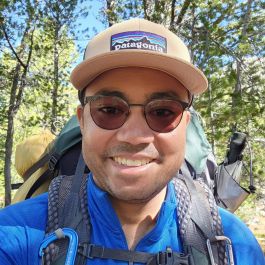J. Auston Ferrarer, EDI '23Research and Leadership Development rotational candidate, Johnson & Johnson

Industry: Medical Technology, Product
Affiliated Programs
Master of Engineering Design Innovation
Alumni Interview
Tell us what your current title is and what your role entails.
I’m in a full time rotational program at Johnson & Johnson called the R&D (Research and Development) Leadership Development Program. My first rotation was as a Development Engineer working on validating and troubleshooting manufacturing equipment used to make staplers used in open surgery for bariatric, thoracic, and colorectal procedures. I’m now entering my 2nd rotation where I’ll be a human factors engineer working with our in-house design team that provides full spectrum support to a variety of product teams. The projects we work on vary in scope from ones that have not yet been chartered (fully funded by the organization) to devices that are almost ready to hit the market, and everything in between. Our job is to ensure that the engineering teams understand the voice of the customer and can use their qualitative feedback given at various stages in the process to inform quantitative design metrics.
When you started EDI, did you know what industry you wanted to work in?
When I joined the EDI program, I had a pretty good idea that I was interested in MedTech because of my experience as a design engineer at Plexus Corporation when I was a Mechanical Engineer fresh out of undergrad. What I didn’t understand was just how broad the product design world was and how much design bleeds into nearly every aspect of our daily lives. Now having graduated for the program and worked for a year in an industry that mandates Human Factors testing as a part of the FDA regulatory submission process, I can directly see how the tools we learned to play with in EDI are directly applicable to this industry.
Tell us about an EDI course that made an impact on you.
Craig Sampson's Design for Product Interaction course was SO MUCH FUN!! It really set the tone for just how omnipresent design is from the way your phone buzzes when you touch it to how cars look on the road! Greg Holderfield’s class on Design Strategy was probably the most practical way to make all the skill sets we learned in the preceding courses come to life, and I loved how he tied it all in with his practical experience working as a designer. I also took a Marketing for Engineers elective course that was cross listed with MPD students and had my mind blown every single class.
What is one lesson you learned during your EDI journey that has stuck with you?
You really can use 2x2s and Desirability, Viability, Feasibility venn diagrams in almost any context and look really smart.
What was your EDI thesis project and what inspired you to pursue it?
My thesis was focused on providing high school students in underprivileged communities with a gamified resource they could use to inform their post graduate career pathways. I personally came from an "engineering family" since both my parents have graduate degrees in technical fields…so there was no lack of inspiration for my sister and I to eventually become engineers ourselves. However, I know for a fact that MANY students in public schools like the one I went to didn’t have these kinds of influences, and therefore assumed that Math & Science couldn’t be for them. I was hoping to challenge the paradigm of what is stereotypically associated with STEAM career finding by giving students the opportunity to discover interests they may not have been exposed to.
What advice do you have for an EDI student interested in working in your industry?
Try it out via an internship and see how you like it! There are so many different entry points to this industry and the first thing you should do is talk to someone who’s been involved in some portion of it.

